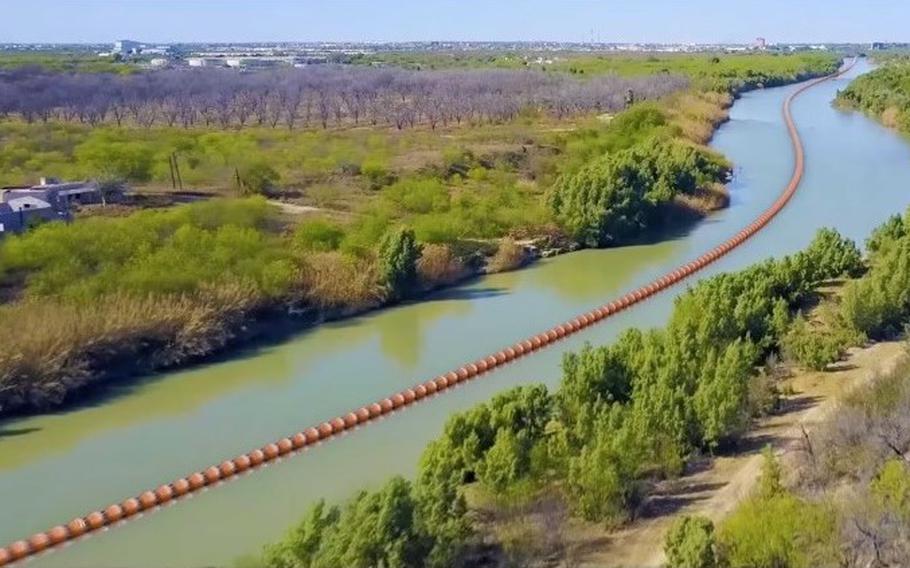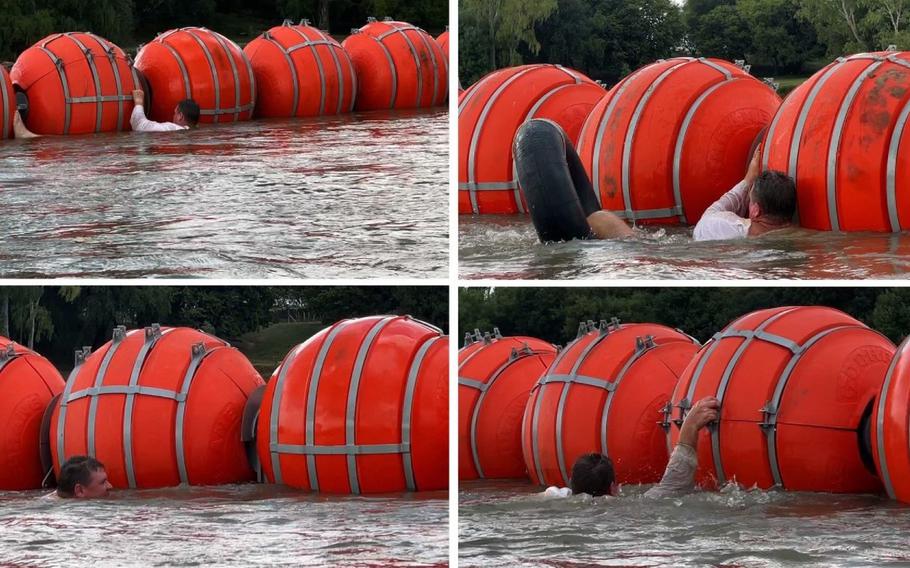
The Texas National Guard will build a buoy barrier later this month on the Rio Grande to deter migrants from crossing the river into Texas from Mexico. (Texas Department of Public Safety)
AUSTIN, Texas — The Texas National Guard will build 1,000 feet of barrier in the Rio Grande using four-foot-tall buoys to deter migrants from crossing into the United States from Mexico between legal ports of entry, Gov. Greg Abbott announced Thursday.
Troops will begin installing the buoys later this month in Eagle Pass, where large groups of people are able to cross shallow water, said Steven McCraw, director of the Texas Department of Public Safety. The buoys will cost nearly $1 million.
The work is part of the state-sponsored mission known as Operation Lone Star, which began more than two years ago to prevent illegal activity such as smuggling drugs and people from Mexico into Texas.
Maj. Gen. Thomas Suelzer, the commander of the Texas National Guard, told state lawmakers that roughly 5,500 troops were deployed to the border for Operation Lone Star, where they work in cooperation with the state police.
The buoys are one piece of a layered barrier approach to prevent and deter people from crossing illegally into Texas, Abbott said. They are in addition to coiled barbed wire that Guard troops have stretched along the border and the patrols conducted by service members on land and water.
“When we are dealing with 100 or 1,000 people, one of the goals is to slow down and deter as many of them as possible,” Abbott said. “Some of them, some, may eventually get to the border where they are going to face that multi-layered razor wire and the full force of National Guard and [state police] officers which they will not be allowed to pass. They both know they have one instruction: do not allow anybody to enter into the state of Texas. Period.”
The buoys will have webbing below the surface of the water to prevent people from swimming under them, McCraw said. They can be quickly moved, as needed, and have been tested by other agencies, including U.S. Customs and Border Protection, he said.

The Texas National Guard will build 1,000 feet of barrier on the Rio Grande later this month using roughly four-foot-tall buoys. (Texas Department of Public Safety )
Crossing the Rio Grande can be dangerous and efforts to do so by migrants have resulted in deaths in some cases, McCraw said.
“We don’t want people to cross and continue to put themselves at risk,” he said.
Abbott made the new barrier announcement during a ceremony to sign six bills into law from the Texas Legislature that relate to border security. Two directly affect the Texas National Guard.
One new law gives Texas military forces the authority to use drones as part of an operation, exercise or mission. It allows the use of drones for search and recovery missions after natural disasters and for monitoring the Texas-Mexico border as part of Operation Lone Star.
The second law authorizes the governor to coordinate and execute an interstate agreement for border security among interested states without congressional approval. The compact will allow participating states to share law enforcement intelligence and resources for heightened detection and deterrence of illegal border activity.
However, the existing Emergency Management Assistance Compact, which allows states to provide resources to each other during emergencies, has already paved the way for 11 states to send National Guard troops to help the border mission in Texas. States fund the border support that they provide Texas, according to the emergency request.
Those states are Florida, Tennessee, Virginia, Iowa, South Carolina, West Virginia, Arkansas, North Dakota, South Dakota, Mississippi and Oklahoma.
“Texas is no longer ground zero for this crisis. Texas is a stronghold. This is exemplified by 11 states sending their National Guards to the Texas border to help protect the nation,” Suelzer said.
Abbott last month called on other states to support Texas, citing a projected surge in illegal activity at the border caused by the May 11 lifting of a public health policy known as Title 42. The policy allowed federal border agents to quickly expel migrants over concern that they would spread the coronavirus.
Those large numbers of migrants have not materialized yet. The Department of Homeland Security said Tuesday that illegal border crossings are down 70% since Title 42 ended.
Operation Lone Star is separate from a federal mission at the border, which has about 1,500 active-duty troops and 2,500 National Guard members authorized to serve across the entire southwest border in support of U.S. Customs and Border Protection agents.
The 1,500 active-duty troops were sent to border for three months to help with a surge of migrants following the lifting of Title 42. Though the surge has not occurred, a Pentagon spokesman said Wednesday that there are no plans to end the mission early.